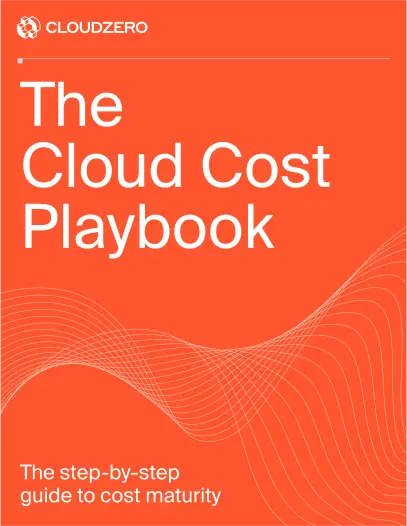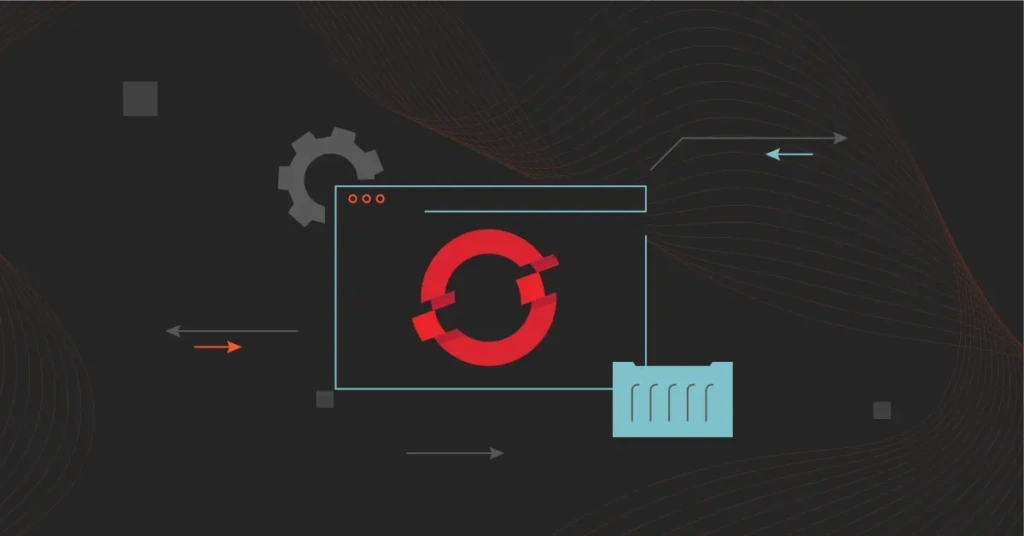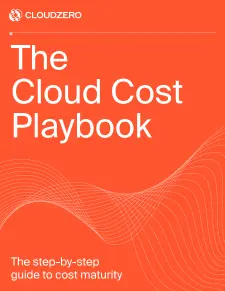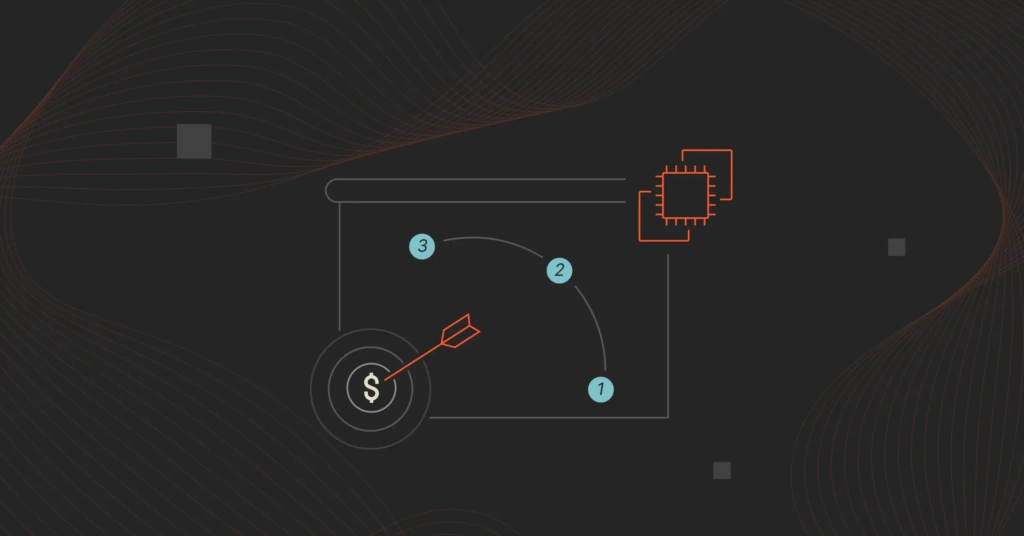OpenShift delivers a lot right out of the box. And for many teams running at enterprise scale, it’s exactly what they need. The platform offers a built-in container registry, observability tools, and service mesh support.
You also get integrations for GitOps, serverless, and even ML workflows. OpenShift combines powerful orchestration with developer tooling, CI/CD pipelines, and enterprise-grade security. All under one roof.
But for others, OpenShift’s pricing, operational overhead, or deep ties to the Red Hat ecosystem don’t align with how their teams are evolving.
If you’re in the latter group, we’ll break down today’s best OpenShift alternatives together. We’ll also highlight what makes each one stand out and help you zero in on the right fit for your architecture, budget, and business goals.
Why You Might Want To Switch From OpenShift
Some teams want more flexibility. Think of a lighter, cloud-native Kubernetes experience they can shape to their needs. Others are scaling across multi-cloud or edge environments and need a platform that won’t add layers of complexity.
Whatever the case, here are some of the top reasons engineering and platform teams start looking beyond OpenShift:
High operational complexity (especially for on-prem/self-managed)
As one Reddit commenter put it, “Using OpenShift is like setting up Kubernetes — but with extra steps and more YAML.”
That’s not just snark. It echoes a common sentiment from teams who’ve wrestled with OpenShift’s complexity. Many report a steep learning curve for administrators, especially when dealing with Operators, SDN configurations, or the challenges of upgrading clusters without disruption.
Higher cost of ownership
Then there’s the cost factor. Once you scale past a small deployment, OpenShift’s pricing model can become a sticking point. These include licensing fees, infrastructure costs, and enterprise support.
Limited customization for advanced K8s users
OpenShift’s opinionated approach brings consistency. For power users, that can feel like a constraint.
If you’re trying to push the envelope with cutting-edge Kubernetes features, custom controllers, or non-standard configurations, OpenShift’s guardrails (and its lag behind upstream releases) can slow you down.
Related read: 10 Top Kubernetes Alternatives (And Should You Switch?)
Red Hat ecosystem lock-in
OpenShift tightly integrates with Red Hat tools like RHEL, CoreOS, and Ansible Automation Platform. This is valuable for some. But for those aiming for a more provider-agnostic or multi-cloud strategy, that tight coupling can feel more like a constraint than a convenience.
Upgrade and maintenance pain points
Upgrades are another pain point, especially in self-managed setups.
Even with solid documentation from Red Hat, users report that minor missteps during upgrades can lead to instability or downtime. For teams running mission-critical workloads, that risk adds extra operational pressure.
Slow adoption of upstream Kubernetes features
OpenShift often trails a version or two behind upstream Kubernetes. That’s a deliberate choice to ensure stability through rigorous testing and validation.
That makes sense for many enterprises. But for teams eager to adopt the latest features, like new CRDs or the Gateway API, the wait can be frustrating and slow down innovation.
What To Look For When Choosing Alternatives To OpenShift
We can agree that OpenShift is powerful. But it’s not irreplaceable. So, if you’re planning to move on, here are the key benchmarks to consider.
- Kubernetes compatibility: The alternative should either be fully Kubernetes-native or offer strong interoperability. This ensures your team can reuse existing manifests, Helm charts, and skills, without vendor-specific lock-in or steep learning curves.
- Security, governance, and compliance: Look for built-in RBAC, network policies, audit logging, and compliance support (HIPAA, SOC 2, and beyond). For instance, if you are an enterprise, platforms like Tanzu or GKE Autopilot offer robust security postures out of the box.
- Cloud-native and multi-cloud flexibility: You’ll want a platform that supports hybrid and multi-cloud setups seamlessly. This is especially critical if you’re running workloads on AWS, Azure, GCP, or across multiple providers. Cloud-managed services often offer deep integration, but tools like Rancher or Platform9 may serve you better in neutral environments.
- Ecosystem support and integrations: Like OpenShift, you’ll want a platform that supports modern CI/CD workflows (like GitOps, ArgoCD, Tekton), observability tools (such as Prometheus, Grafana, Datadog), and security tooling (including OPA/Gatekeeper, Kyverno, Istio). Best to avoid platforms that limit which tools you can use.
- Cost transparency and efficiency: Many teams abandoned OpenShift due to its high total cost of ownership. The infrastructure required to support it, in particular, can be quite hefty. So, to optimize your costs, look for platforms with clear pricing, ideally pay-as-you-go (usage-based).
- Ease of operation and maintenance: Not all teams have dedicated Kubernetes platform engineers. Managed services, such as GKE, AKS, or EKS, offload control plane management and upgrades. Better yet, lightweight distributions like K3s or hosted platforms like Platform9 can further reduce your hands-on maintenance.
Related read: K3s Vs K8s: What’s The Difference? (And When To Use Each)
- Modularity and customization: If you want the freedom to build a custom stack, such as integrating specific ingress controllers, service meshes, or autoscaling tools, choose a platform that stays close to upstream Kubernetes and doesn’t enforce rigid defaults.
- Scalability and enterprise support: For large-scale environments or regulated industries, you’ll want enterprise support, SLAs, and features like multi-tenancy, policy enforcement, and autoscaling. Also, evaluate vendor track records and support quality before committing.
With that in mind, we’ve grouped the top OpenShift alternatives by their best-fit use cases. This way, you can compare them directly to what OpenShift offers.
The Best OpenShift Alternatives To Consider Right Now
For each, we’ll cover what it is, who it’s for, standout features, quick pros and cons, and why it might be a better fit depending on your needs.
The major Kubernetes-based platforms similar to OpenShift
If you want the closest match to OpenShift’s feature set, start with the top picks in this group. Think of container orchestration, application lifecycle management, and enterprise features for deploying and managing containerized applications.
1. Rancher (by SUSE)
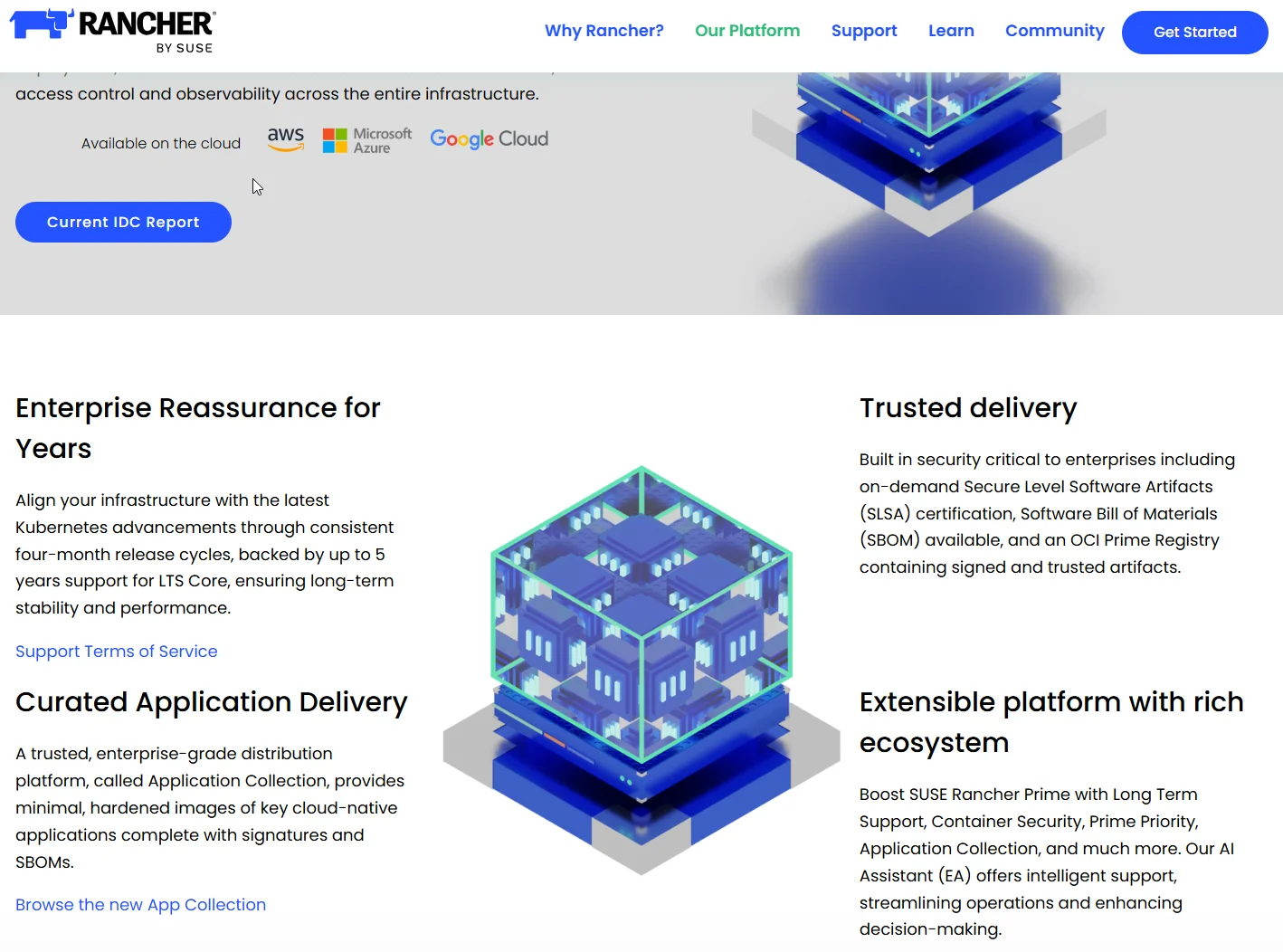
Like OpenShift, Rancher’s Kubernetes management platform simplifies cluster operations across on-prem, public cloud, and edge environments. It’s fully open-source and supports upstream Kubernetes.
Who it’s for: Organizations managing multiple Kubernetes clusters (self-hosted or cloud-native) looking for a unified control plane without vendor lock-in.
Key Rancher features:
- Centralized management for multi-cluster Kubernetes
- Full support for RKE, RKE2, K3s, and upstream K8s
- Built-in RBAC, authentication integrations (AD, LDAP, etc.)
- UI and CLI-based workload deployment
- CIS benchmark scanning and policy enforcement
Pros:
- Open-source and vendor-neutral
- Works well with hybrid and edge setups
- Supports custom configurations and integrations
Cons:
- May require some setup and infrastructure expertise
- Limited native CI/CD features compared to OpenShift
2. VMware Tanzu Kubernetes Grid
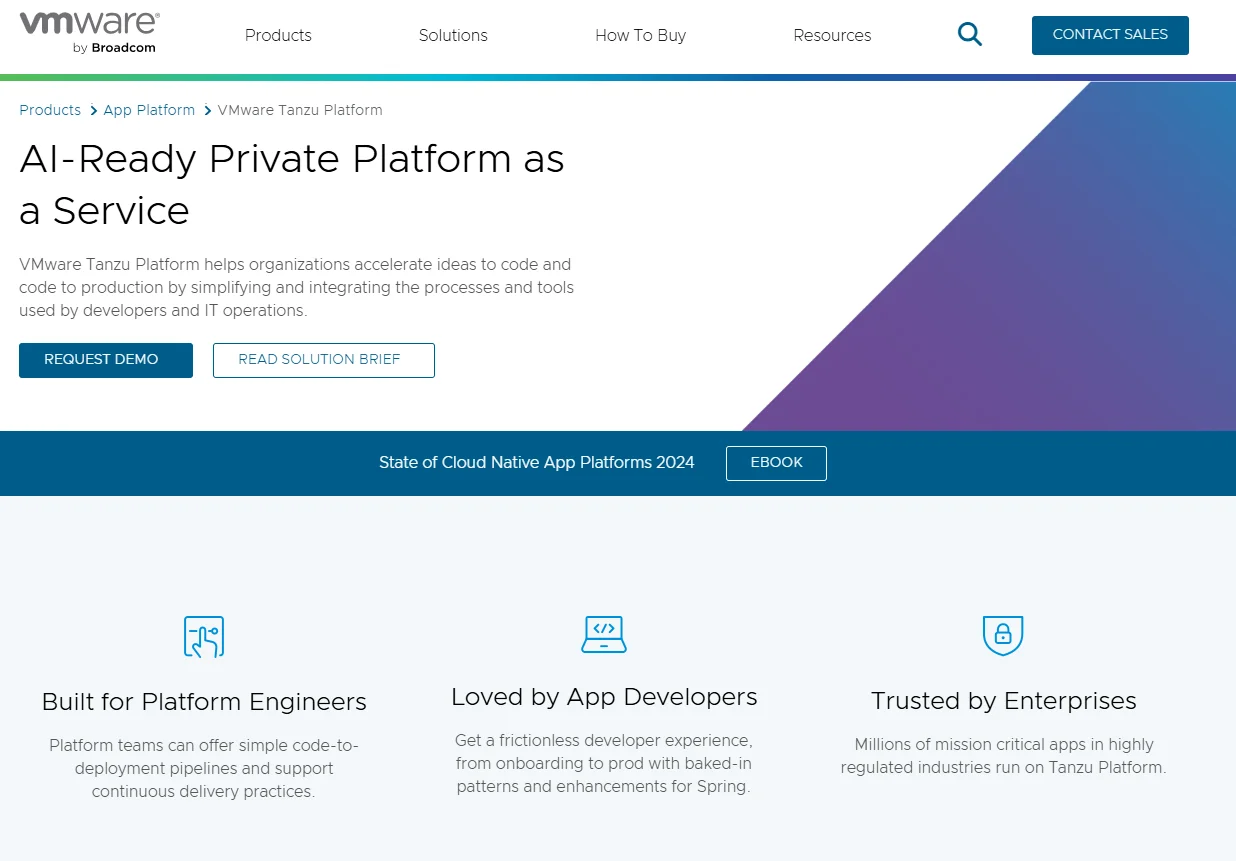
This is VMware’s Kubernetes platform. Tanzu Kubernetes Grid (TKG) is designed to run seamlessly across vSphere, public clouds, and edge infrastructure, with enterprise-grade governance.
Who it’s for: Enterprises already invested in the VMware ecosystem that want to modernize their apps without re-architecting everything.
Key TKG features:
- Integrated with vSphere for virtualization-native Kubernetes
- Supports multi-cloud and hybrid cloud deployment
- Built-in observability, policy, and identity management
- Lifecycle management through Tanzu Mission Control
- Includes Harbor Registry, Velero backup, and FluxCD
Pros:
- Familiar environment for VMware users
- Strong governance and compliance features
- Streamlined infrastructure-to-app workflow
Cons:
- Best suited to organizations already using VMware
- It may be overkill or too complex for cloud-native startups
3. Mirantis Kubernetes Engine (formerly Docker Enterprise)
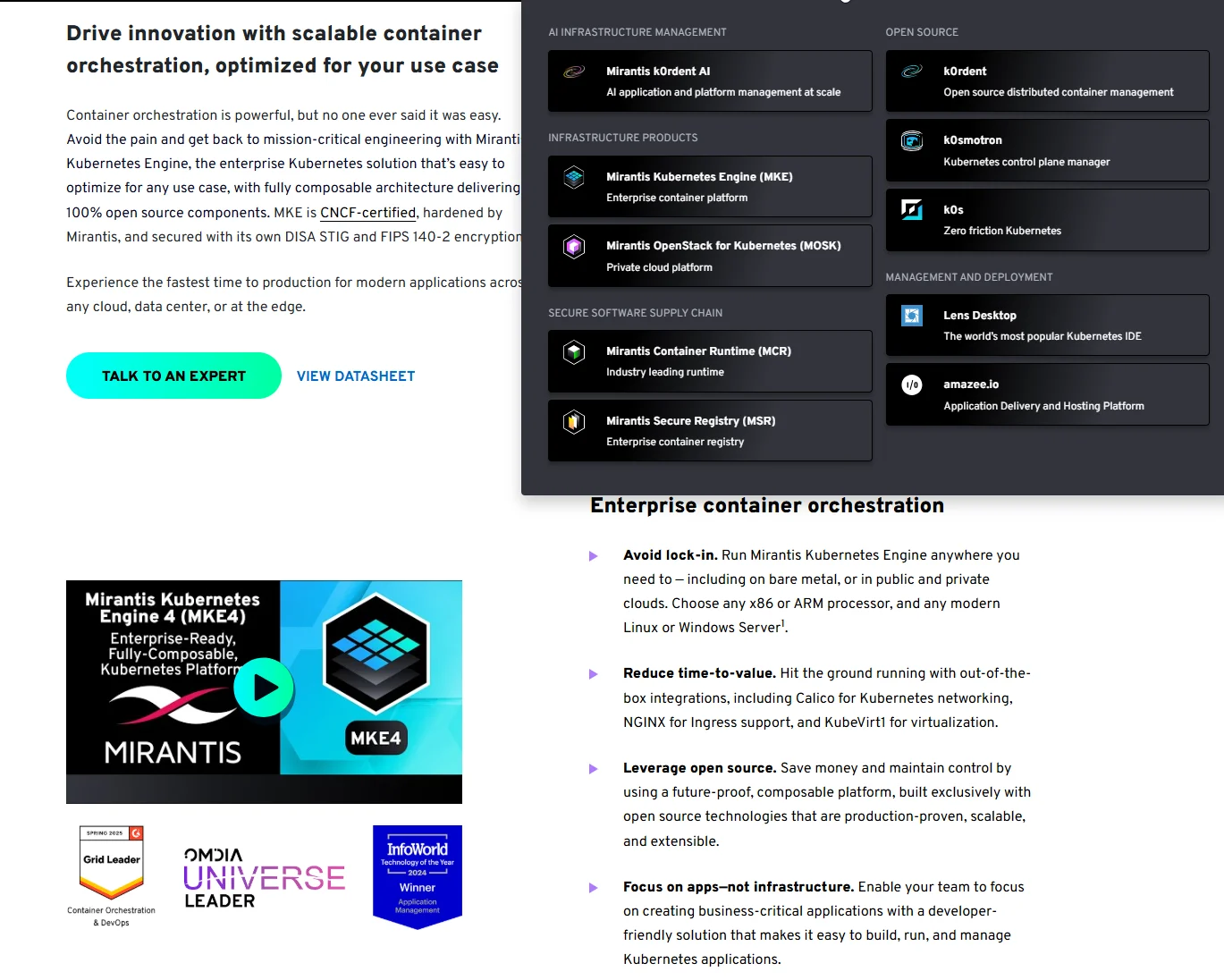
Mirantis Kubernetes Engine offers a secure, production-grade Kubernetes platform. It comes with Docker Enterprise features baked in. That includes integrated Swarm support for legacy workloads and robust lifecycle tooling to simplify day-to-day ops.
Who it’s for: Enterprises that need robust security, air-gapped deployments, and multi-cluster
management, especially in regulated or complex environments.
MKE features:
- Secure-by-default Kubernetes and Docker Swarm support
- Private registry with image scanning and policy enforcement
- Role-based access control (RBAC) and LDAP integration
- Automated updates and lifecycle management
- Works in air-gapped environments
Pros:
- Strong security posture and enterprise support
- Ideal for regulated industries
- Includes legacy Docker support and migration tooling
Cons:
- Less community visibility than some alternatives
- Steeper learning curve if not familiar with Docker Enterprise
Managed Kubernetes platforms as OpenShift alternatives
This group includes cloud-managed Kubernetes solutions that offer many of the automation, scaling, and security features you’ve come to expect from OpenShift.
4. Google Kubernetes Engine (GKE)
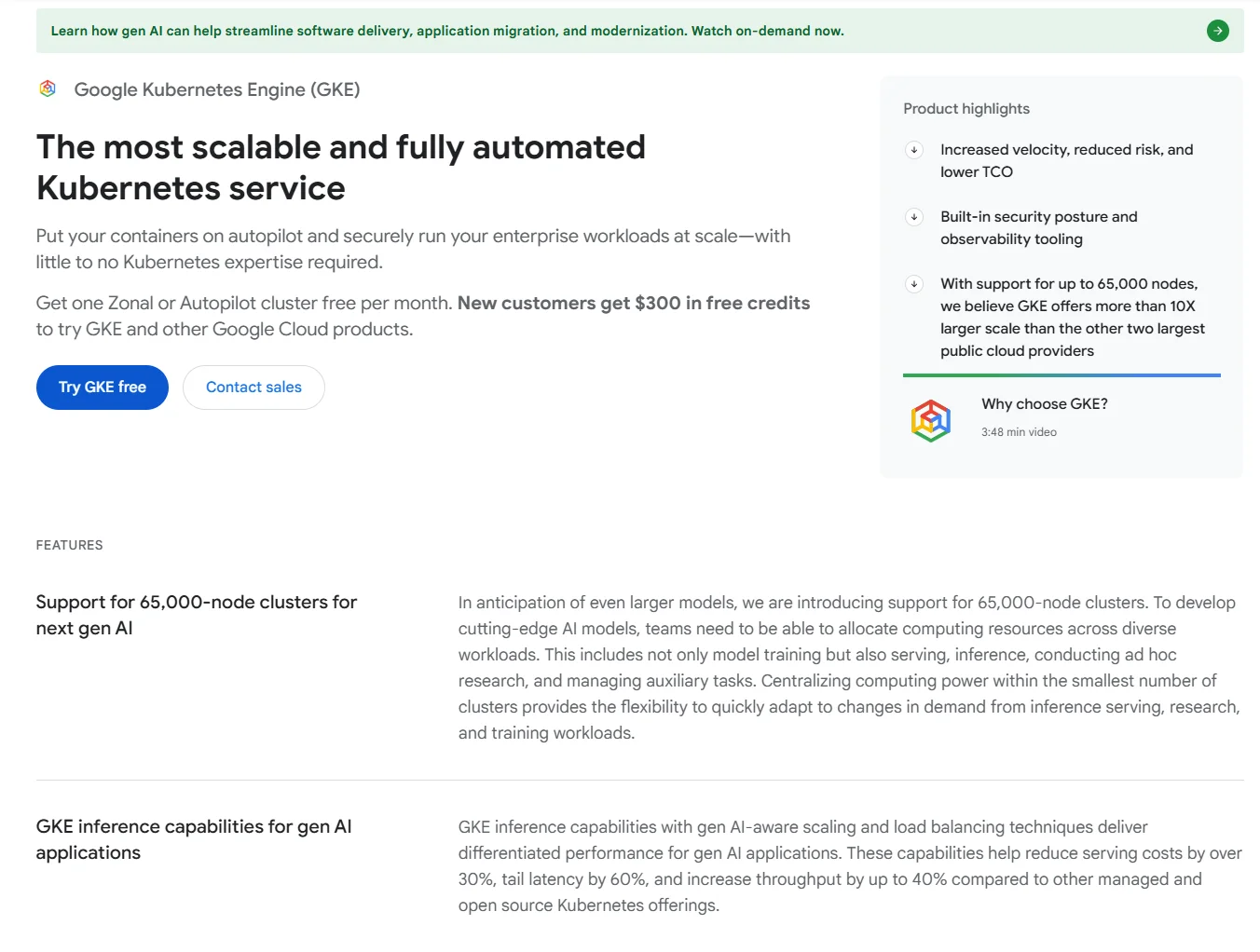
Google Cloud’s fully managed Kubernetes service is widely regarded as one of the most mature and performant offerings on the market.
Who it’s for: Look into GKE if you are prioritizing automation, rapid deployment, and advanced scaling capabilities. It is especially ideal in data-heavy or AI/ML environments.
GKE features:
- Fully managed clusters with auto-upgrades and node repair
- Autopilot mode for hands-off Kubernetes
- Deep integration with Google services (BigQuery, Vertex AI, etc.)
- GKE cost optimization tools and autoscaling
- Anthos support for hybrid/multi-cloud workloads
Pros:
- Provides a balance of simplicity, performance, and advanced features
- Fast, stable, and easy to manage at scale
- Autopilot mode minimizes operational burden
- Industry-leading autoscaling and cost controls
Cons:
- Less flexibility in Autopilot mode
- Best suited for GCP-centric environments
Also see:
5. Amazon Elastic Kubernetes Service (EKS)
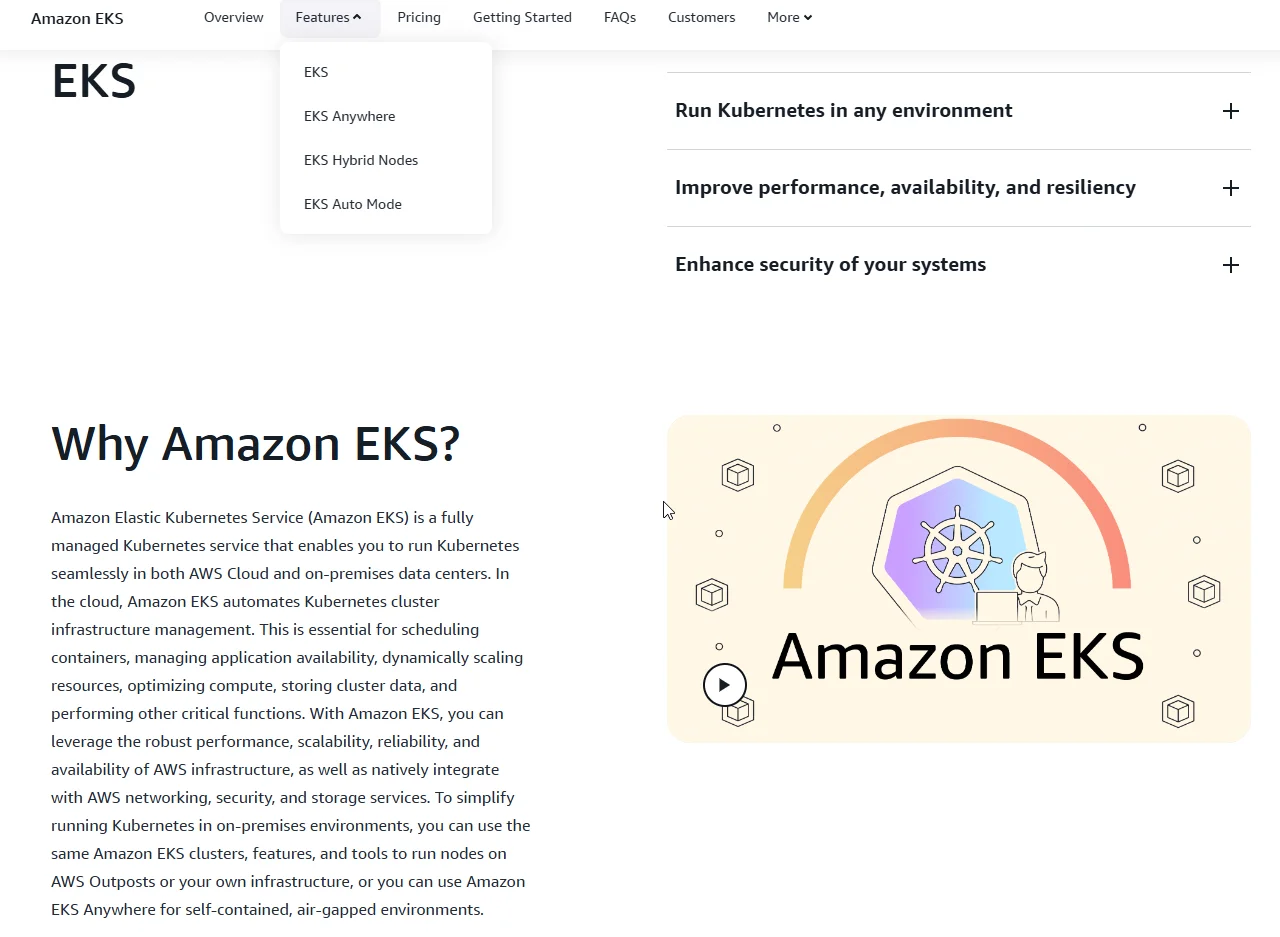
For AWS-native teams, Amazon EKS delivers many of the same advantages as OpenShift. Think security, automation, and scalability. Added benefits include being fully managed and deeply integrated with the broader AWS ecosystem, including services like Amazon EC2, IAM, and CloudWatch.
Who EKS is for: Teams already running workloads on AWS who want managed Kubernetes with high availability, scalability, and deep integration into the AWS ecosystem.
Key EKS features:
- Fully managed control plane
- Native IAM integration and fine-grained access control
- Works with Fargate for serverless pods
- Integrates with CloudWatch, Load Balancers, and EBS
- Amazon EKS Blueprints for quick setup of best practices
Pros:
- Offloads Kubernetes control plane management
- Highly scalable and production-ready
- Seamless AWS ecosystem integration
Cons:
- Tightly coupled to AWS (limited multi-cloud portability)
- Complex pricing model (compute + control plane + extras)
Related read: EKS Pricing In 2025: Understand And Optimize Your EKS Costs
6. Platform9 Managed Kubernetes

Platform9 brings the ease of cloud-native Kubernetes to wherever you run (on-prem, in the cloud, or at the edge). It delivers SaaS-managed Kubernetes without the operational burden, allowing you to get the benefits of a managed service without giving up control over your infrastructure.
Who it’s for: Teams that want the power of Kubernetes without managing control planes, upgrades, or infrastructure, especially in hybrid environments.
Key features:
- Manage Kubernetes on any infrastructure (bare metal, cloud, VMs)
- Zero-touch upgrades and 24/7 monitoring
- Pre-integrated GitOps, Prometheus, and ArgoCD
- Multi-cluster management from a single console
- SLA-backed enterprise support
Pros:
- Cloud-like Kubernetes on your infrastructure
- Great for hybrid/multi-cloud setups
- Developer-friendly experience without vendor lock-in
Cons:
- Smaller ecosystem compared to hyperscaler offerings
- Paid plans are required for full enterprise features
Developer-Centric OpenShift Alternatives
The platforms in this section give your team more control. They help you tweak, manage, and optimize your Kubernetes setup to fit your unique goals without compromising stability.
7. Canonical Kubernetes (Charmed Kubernetes)
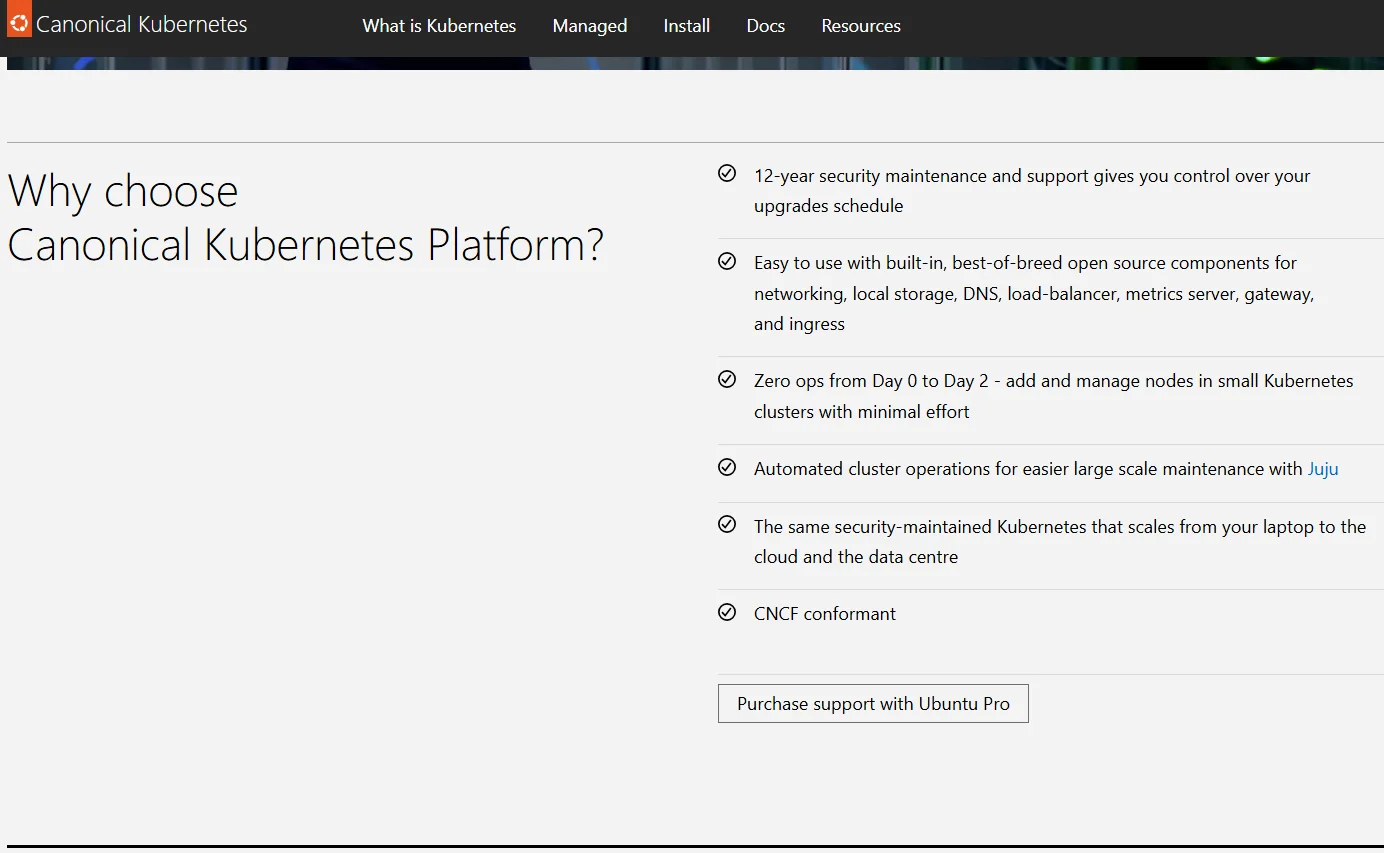
Canonical’s Kubernetes distribution is highly customizable, offering control without sacrificing support. It is open-source with long-term support, full upstream-compliant, and automates lifecycle management using Juju charms.
Who it’s for: Teams that want full control of their Kubernetes environment with enterprise support, especially on Ubuntu-based systems.
Key features:
- Open-source, upstream Kubernetes with 12-year support (LTS)
- Automated installation via Juju charms
- Pre-integrated with Prometheus, Grafana, and Fluentd
- Works across bare metal, VMs, and clouds
- Full-stack observability and security hardening
Pros:
- Highly customizable, no vendor lock-in
- Long-term security updates and support
- Works well with Ubuntu/Canonical stack
Cons:
- Requires more hands-on management
- Smaller commercial ecosystem compared to Red Hat or VMware
8. Northflank
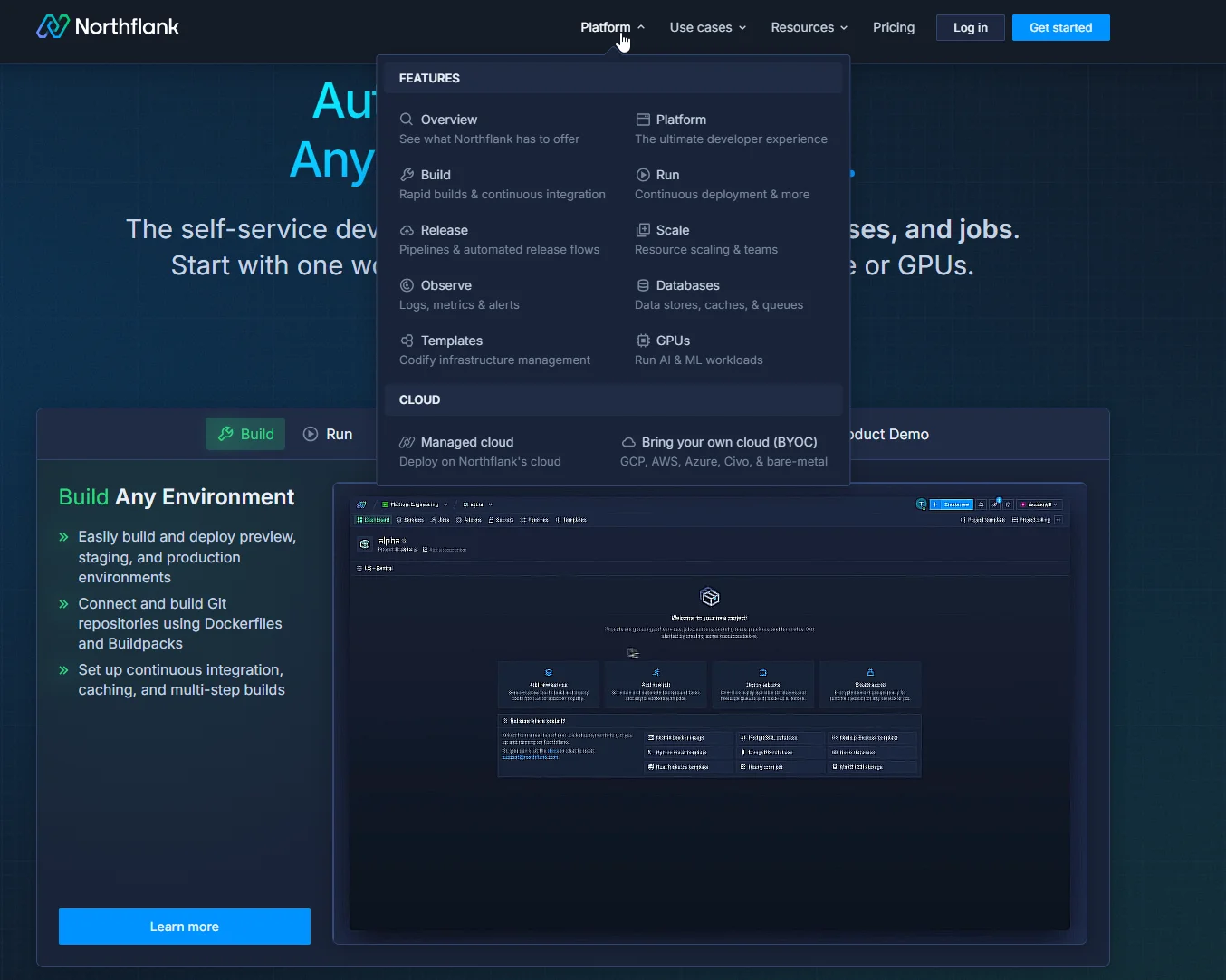
Northflank is a developer-first platform that wraps infrastructure automation, continuous deployment, and service management into one clean, easy-to-use interface—all built natively on Kubernetes. And all to hand your dev teams serious power without the usual K8s overhead.
Who it’s for: Startups, scale-ups, and product teams that want to ship fast without managing Kubernetes complexity. Ideal for teams focused on microservices, APIs, and modern app delivery.
Key features:
- Git-based continuous deployment out of the box
- Deploy containers, databases, and cron jobs in seconds
- Built-in logging, metrics, and autoscaling
- Fully managed infrastructure on top of Kubernetes
- Dockerfile and buildpack support
Pros:
- Extremely developer-friendly and intuitive UI/UX
- Abstracts away your Kubernetes infrastructure but still runs on K8s
- Fast deployment with minimal ops involvement
Cons:
- Limited deep customization (not ideal for complex infrastructure needs)
- Not yet as mature as the mainstream platforms
9. Qovery
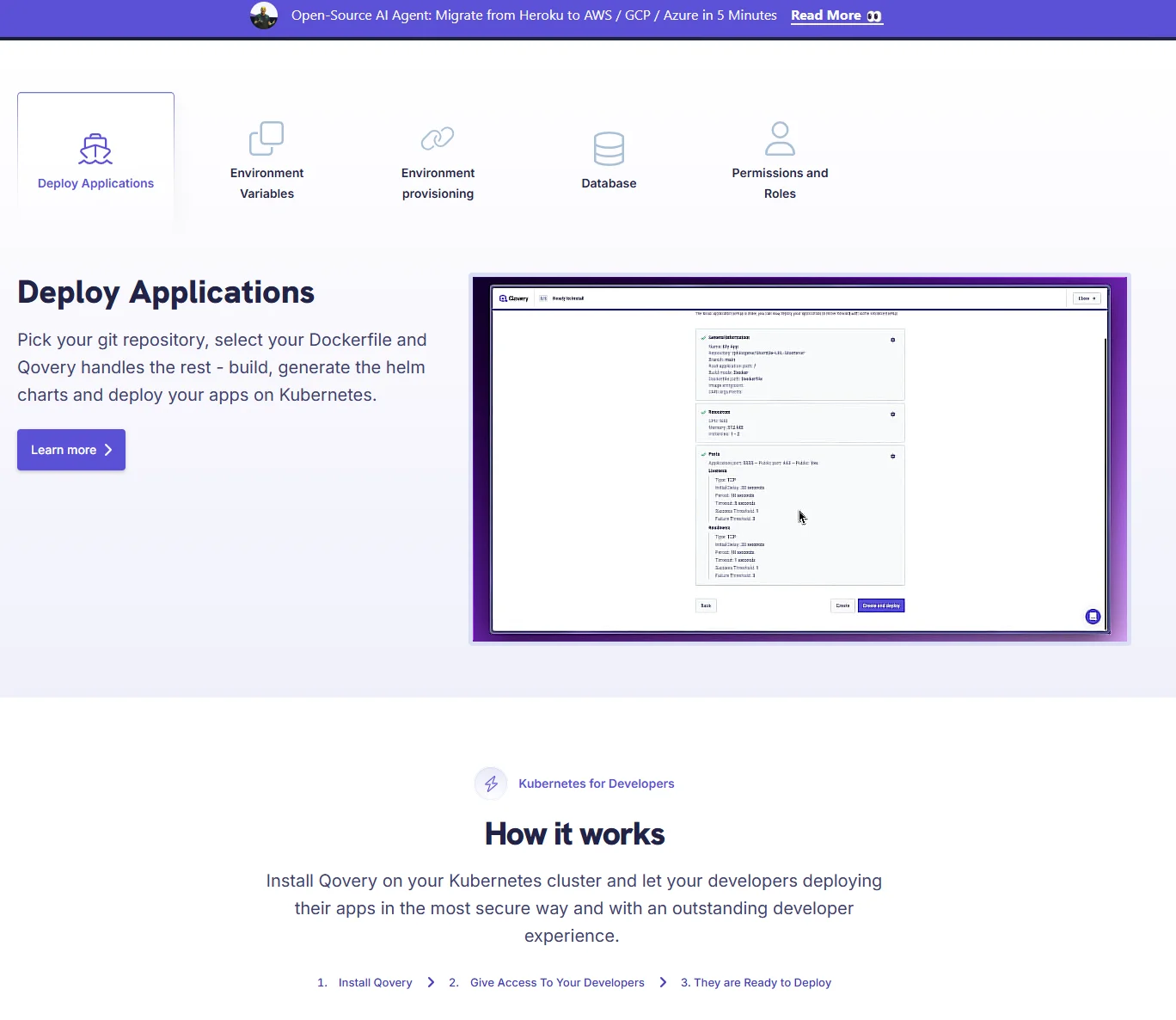
Qovery is a platform-as-a-service (PaaS) built on Kubernetes. It helps developers deploy apps to AWS, Azure, or GCP with zero infrastructure knowledge required.
Who it’s for: Dev teams that want the Heroku-like developer experience but need Kubernetes and public cloud infrastructure’s power, scalability, and flexibility.
Key features:
- Instant environment creation from Git repositories
- One-click preview environments for every pull request
- Built-in autoscaling, service discovery, and secrets management
- Multi-cloud support (AWS, Azure, GCP)
- Dev-to-prod consistency with isolated environments
Pros:
- Streamlined, Heroku-style workflow on top of Kubernetes
- Automates all infrastructure provisioning and scaling
- Perfect for staging, QA, and ephemeral environments
Cons:
- Less control over infrastructure internals
- Focused more on developers than platform engineers
Take Control of Your Kubernetes Costs — No Matter What Platform You Choose
OpenShift isn’t the only option anymore. And that’s a good thing.
From cloud-native platforms like GKE and Rancher to developer-first options like Canonical and Northflank, you have more freedom today than ever to build your ideal Kubernetes stack. But no matter which path you take, one challenge stays the same:
If you can’t see where your Kubernetes spend is going, you can’t control or optimize it.
That’s where CloudZero makes all the difference.
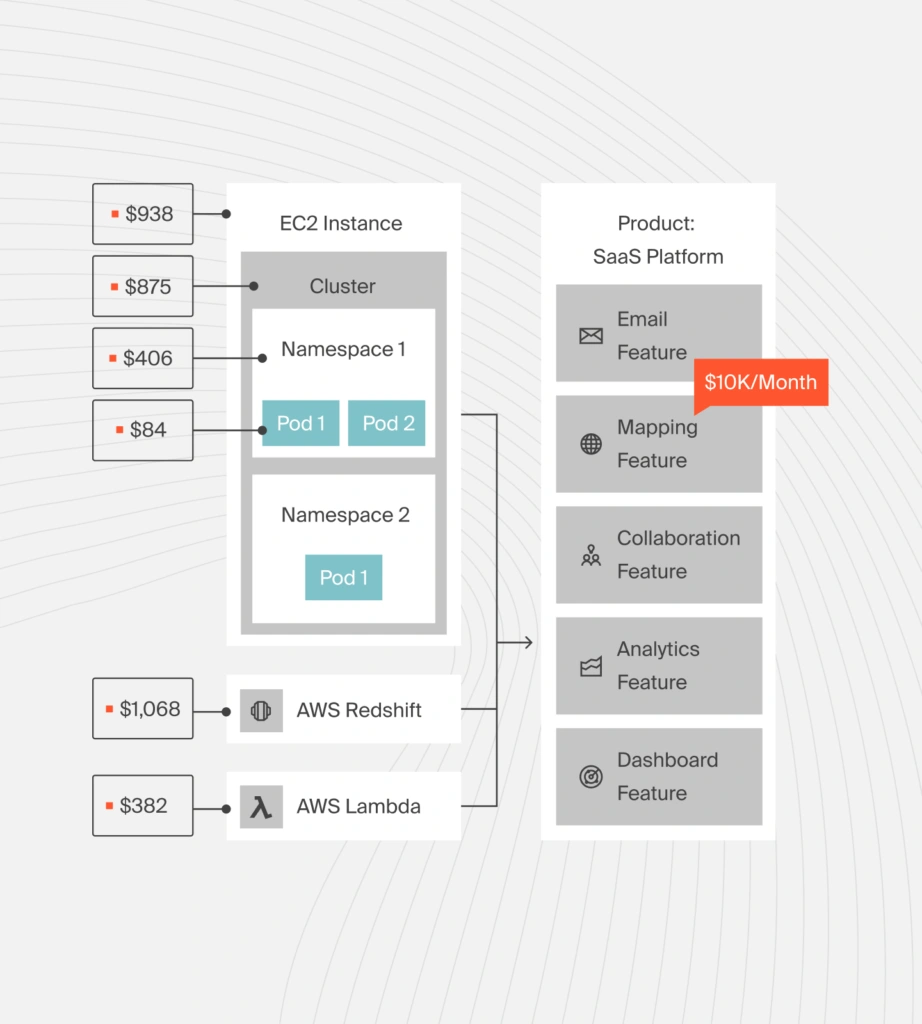
CloudZero gives you the kind of cost intelligence that Kubernetes doesn’t come with out of the box. We help you:
- Get best-in-category Kubernetes cost visibility. Break down spend by team, product, microservice, customer, and beyond for precise visibility.
- See exactly where your Kubernetes spend is going — across clusters, namespaces, and workloads. Then take the next step with total cost confidence.
- Catch cost anomalies in real time with smart, noise-free alerts delivered straight to your inbox. That way, you can stop overspending before it eats into your margins.
- Give your engineers the cost context they need. It’s how you keep finance and engineering aligned, protect your margins, and still move fast without compromising performance or user experience.
Unlike platforms that only work with AWS or demand flawless tagging, CloudZero gives you clear Kubernetes cost visibility. Across any cloud. Any cluster. And even if you have messy or missing tags.
So no matter which OpenShift alternative you choose, you don’t have to fly blind. You can join ambitious teams like Moody’s, Skyscanner, and Grammarly, who already use CloudZero to optimize their Kubernetes costs and ROI. It’s risk-free.  and see what cost-intelligent Kubernetes looks like in action.
and see what cost-intelligent Kubernetes looks like in action.
